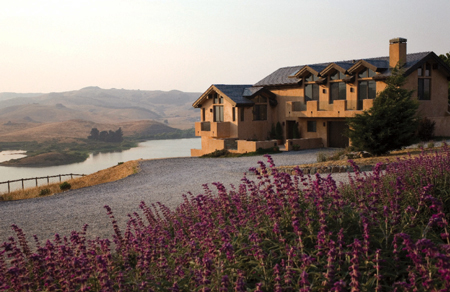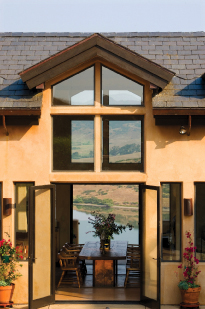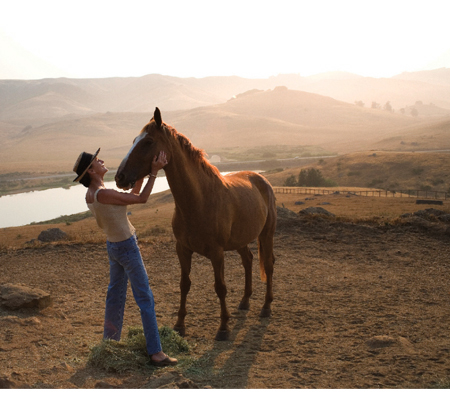Ever since she took riding lessons as a child in her native Denmark, Karin Dilou wanted to live surrounded by her beloved horses, but not just in any house and not just on any piece of land.
“I had a dream about a little place in the countryside where I could have my horse and no neighbors and, because I’m a Viking, a view of the water,” she says.
In 1996, Dilou found her dream: a 35-acre grassy perch high above picturesque Nicasio Reservoir, where weekend fishermen set their lines on the shore and waterbirds preen and glide in the sparkling water. There was only one obstacle. The property wasn’t for sale — yet.
“After I saw it, I knew I didn’t want anything else,” she says. She knew she’d “never see anything as beautiful again no matter where I went. I had to have it.” Dilou made an unsolicited offer to the landowner, and he accepted. Her next thought: “I’ll never be able to afford to build a house there.”
An importer/exporter of Danish products and, at the time, a young single mother of two boys, Dilou concentrated on expanding her business while paying for each stage of her new home’s construction. She oversaw the project from a trailer parked on site with two loose telephone lines, an outhouse, a generator and no water.
“I always say, ‘If you start to pursue a dream, you’re halfway there, but be careful what you dream for. It’s a lot of work.’”
From the reservoir’s shore below, Dilou’s two-story, L-shaped home, named Danehill, rises like a small European castle, its sharply peaked rooflines and strong facade creating an imposing solitary presence. Off to the side, a long driveway wends its way uphill past a neighbor’s acreage and dead-ends at hers, where a roundabout separates the house and barn.
“It’s a fabulous party house,” she says. Guests move through the house, wander onto terraces, gather in the poolside courtyard or visit the horses. She’s hosted hunt breakfasts for the Los Altos Hounds, held events for various charities and entertained members of the Danish Warmblood Registry of America, of which she is president.
Dilou has also offered her home to friends for weddings and parties. One of these friends, former KGO-TV meteorologist Joel Bartlett, held his retirement party there recently and pastures his horse, Domingo, there.
“It takes your breath away when you first come over the ridge and see the house, the reservoir in the background and, beyond that, the coastal Marin hills,” Bartlett says. “It’s pretty spectacular.”
Although she initially drew upon the talents of a local designer, Dilou concedes the design is all hers. While there is some resemblance to a Danish slot, or castle, she actually wanted the look of a Danish farmhouse or even its American equivalent, the Southwestern adobe. But building costs curtailed some architectural details: there are the deep-set windows and round-edged interior walls and two kiva-style fireplaces, but not the more expensive, curved gables she had envisioned. She smiles and shrugs. “I’m frugal.”
The house is sited near a large rock outcropping, part of which extends into the living room wall, and a 400-year-old spreading Bay Laurel tree with massive exposed roots. Landscaping is kept natural, with only selected areas cultivated with plantings of drought-tolerant Mexican sage, lavender and rosemary. Inside, there are four bedrooms, an office, mudroom and wine cellar. “Danish people used to have saunas in their homes, but it cost too much to heat so they turned them into wine cellars,” she says. She skipped a step and “built the wine cellar directly.”
Her master bedroom, bathed in morning light, is close to the pool and hot tub for quick dips before work and lingering soaks at dusk, or what she calls the “blue hour” of the evening, “one of the things I miss most about Denmark.”
Dilou’s design philosophy holds that “a home should be where you exhale and rest with nothing to disturb the eye.” So her refrigerator is tucked away in the pantry, and there are no draperies to block the view and no distracting lamps overhead. A restful color palette is pulled from the landscape, with a blue Pebbletec surface for the saltwater pool that mirrors the water of the reservoir, an exterior stucco that reflects the yellow grass of summer, and concrete floors in the exact color of the native soil. It makes her feel “like I live in a piece of art.”
She also insisted on using natural and economical materials. Salvaged redwood from a dismantled warehouse in San Francisco’s China Basin was fashioned into a 14-foot-long dining table, a kitchen ledge and extra-wide spacers in the concrete floor. Concrete was also used for the countertops, terraces and patio table.
She clad the pedestals of the dining room table in sheets of weathered copper, complementing the copper backsplash and curved wall sconces she designed. “They give the room a warm glow and make it cozy,” she says, “but they’re just wrapped around a $2.95 light fixture from Home Depot.”
Dilou decorates with an easy mix of her heritage and her passion. From Denmark, there are her mother’s antique rosewood secretary, an ancestral portrait and a pair of inherited carved dining room chairs; from the equestrian world, there are framed riding prints and a large cast-iron replica of a Ming dynasty horse purchased on a business trip to Mongolia.
Still, the view is the main focus and she “squeezed in as many windows as the law allowed. Every room has a view,” she says, including those in the barn, the tree house and the master suite dressing room. “Even when I get dressed, I don’t want to miss a second. From everywhere, I can still see my horses.”
The barn may have been the primary motivation for building the house, but the horses are rarely stabled. Her eight dressage-trained Danish Warmbloods, a breed known for beauty and athleticism, spend their days grazing in the two large pastures that compose most of the acreage. “It’s so much healthier for them and horses really don’t like to be inside, especially if they’ve been brought up in pastures.”
Still, the barn has not escaped Dilou’s attention. She designed the stall latches and clever collapsible saddle racks herself, embellishing them with tiny horseshoes.
And her penchant for design hasn’t escaped her youngest son’s eye. Marc-Christian, a 17-year-old student at Sonoma State University, is considering a career in architecture. “This is such a unique house and my mom did it all,” he says. “I remember it was a lot of work, but it was fun at the same time.”


